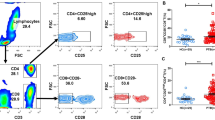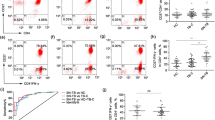Abstract
Monitoring tuberculosis (TB) treatment success is crucial for clinical decision-making. The only available tool in this regard is sputum microscopy, but it has demerits. Moreover, in case of smear negatives and extrapulmonary TB, an efficient tool is still sought for. Therefore, we evaluated T regulatory cell (Treg)-associated markers (CD25, CD39, and FoxP3) and cellular subsets in monitoring treatment success in treatment-completed groups. Expression profile of various markers and subsets were compared real time among treatment-naive pulmonary TB patients (TN-PTB), followed-up treatment-completed (TC-fu) cohort, and a not followed-up (TC-nfu) cohort. Peripheral blood mononuclear cells from various groups were incubated overnight and were stained with antibodies for specific markers and studied by flow cytometry. In both the treatment-completed groups, a decline in frequencies of CD25+ marker and CD4+CD25+, CD4+CD25+FoxP3, CD4+CD25+CD39+ Treg was observed with clearance of infection, indicating their potential in monitoring treatment success. However, in the case of treatment failure patient (Tfp), a drastic increase in frequency of CD4+CD25+FoxP3+ Treg subset was found, indicating its usefulness in predicting treatment failure. Although the investigation unveils markers useful in predicting treatment success or failure, the findings from this study needs to be validated in a larger cohort.







Similar content being viewed by others
References
World Health Organization, Global Tuberculosis Report 2017. WHO report, Geneva (WHO/HTM/TB/2017.23). 2017. Available from: http://www.who.int/tb/publications/global_report/en/
Parkash O, Agrawal S, Madhan MK. T regulatory cells: Achilles’ heel of Mycobacterium tuberculosis infection? Immunol Res. 2015;62:386–98. https://doi.org/10.1007/s12026-015-8654-0.
How SH, Kuan YC, Ng TH, Razali MR, Fauzi AR. Monitoring treatment response in sputum smear positive pulmonary tuberculosis patients: comparison of weight gain, sputum conversion and chest radiograph. Malays J Pathol. 2014;36:91–6.
Horne DJ, Royce SE, Gooze L, Narita M, Hopewell PC, Nahid P, et al. Sputum monitoring during tuberculosis treatment for predicting outcome: systematic review and meta-analysis. Lancet Infect Dis. 2010;10:387–94. https://doi.org/10.1016/S1473-3099(10)70071-2.
Caulfield AJ, Wengenack NJ. Diagnosis of active tuberculosis disease: from microscopy to molecular techniques. J Clin Tuberc Other Mycobact Dis. 2016;4:33–43. https://doi.org/10.1016/j.jctube.2016.05.005.
Agrawal S, Parkash O, Palaniappan AN, Bhatia AK, Kumar S, Chauhan DS, et al. Efficacy of T regulatory cells, Th17 cells and the associated markers in monitoring tuberculosis treatment response. Front Immunol. 2018;9:157. https://doi.org/10.3389/fimmu.2018.00157.
Adekambi T, Ibegbu CC, Cagle S, Kalokhe AS, Wang YF, Hu Y, et al. Biomarkers on patient T cells diagnose active tuberculosis and monitor treatment response. J Clin Invest. 2015;125(9):3723. https://doi.org/10.1172/JCI83279.
Treatment of Tuberculosis: guidelines. 4th ed. Geneva: World Health Organisation 2010.
Allen BW. Modified Petroff technique treatment of specimens, chapter 3. In: Baker FJ, editor. Mycobacteria isolation, identification and sensitivity testing. London: Butter Worth and Co; 1968. p. 9–16.
Guyot-Revol V, Innes JA, Hackforth S, Hinks T, Lalvani A. Regulatory T cells are expanded in blood and disease sites in patients with tuberculosis. Am J Respir Crit Care Med. 2006;173:803–10. https://doi.org/10.1164/rccm.200508-1294OC.
Welsh KJ, Risin SA, Actor JK, Hunter RL. Immunopathology of postprimary tuberculosis: increased T-regulatory cells and DEC-205-positive foamy macrophages in cavitary lesions. Clin Dev Immunol. 2011;2011:307631–9. https://doi.org/10.1155/2011/307631.
Wu YE, Peng WG, Cai YM, Zheng GZ, Zheng GL, Lin JH, et al. Decrease in CD4+CD25+FoxP3+ Treg cells after resection in the treatment of cavity multidrug-resistant tuberculosis. Int J Infect Dis. 2010;14:e815–22. https://doi.org/10.1016/j.ijid.2010.04.005.
Churina EG, Urazova OI, Novitskiy VV. The role of Foxp3-expressing regulatory T cells and T helpers in immunopathogenesis of multidrug resistant pulmonary tuberculosis. Tuberc Res Treat. 2012;2012:931291–9. https://doi.org/10.1155/2012/931291.
Lim HJ, Park JS, Cho YJ, Yoon HI, Park KU, Lee CT, et al. CD4(+)FoxP3(+) T regulatory cells in drug-susceptible and multidrug-resistant tuberculosis. Tuberculosis (Edinb). 2013;93:523–8. https://doi.org/10.1016/j.tube.2013.06.001.
Li N, Xie WP, Kong H, Min R, Hu CM, Zhou XB, et al. Enrichment of regulatory T-cells in blood of patients with multidrug-resistant tuberculosis. Int J Tuberc Lung Dis. 2015;19:1230–8. https://doi.org/10.5588/ijtld.15.0148.
Feruglio SL, Tonby K, Kvale D, Dyrhol-Riise AM. Early dynamics of T helper cell cytokines and T regulatory cells in response to treatment of active Mycobacterium tuberculosis infection. Clin Exp Immunol. 2014;179:454–65. https://doi.org/10.1111/cei.12468.
de Almeida AS, Fiske CT, Sterling TR, Kalams SA. Increased frequency of regulatory T cells and T lymphocyte activation in persons with previously treated extrapulmonary tuberculosis. Clin Vaccine Immunol. 2012;19:45–52. https://doi.org/10.1128/CVI.05263-11.
Ribeiro-Rodrigues R, Resende Co T, Rojas R, Toossi Z, Dietze R, Boom WH, et al. A role for CD4+CD25+ T cells in regulation of the immune response during human tuberculosis. Clin Exp Immunol. 2006;144:25–34. https://doi.org/10.1111/j.1365-2249.2006.03027.x.
Singh A, Dey AB, Mohan A, Sharma PK, Mitra DK. Foxp3+ regulatory T cells among tuberculosis patients: impact on prognosis and restoration of antigen specific IFN-γ producing T cells. PLoS One. 2012;7:e44728. https://doi.org/10.1371/journal.pone.0044728.
Jackson-Sillah D, Cliff JM, Mensah GI, Dickson E, Sowah S, Tetteh JK, et al. Recombinant ESAT-6-CFP10 fusion protein induction of Th1/Th2 cytokines and FoxP3 expressing Treg cells in pulmonary TB. PLoS One. 2013;8:e68121. https://doi.org/10.1371/journal.pone.0068121.
Arram EO, Hassan R, Saleh M. Increased frequency of CD4+CD25+FoxP3+ circulating regulatory T cells (Treg) in tuberculous patients. Egypt J Chest Dis Tuberc. 2014;63:167–72. https://doi.org/10.1016/j.ejcdt.2013.10.013.
Chen X, Zhou B, Li M, Deng Q, Wu X, Le X, et al. CD4(+) CD25(+) FoxP3(+) regulatory T cells suppress Mycobacterium tuberculosis immunity in patients with active disease. Clin Immunol. 2007;123:50–9. https://doi.org/10.1016/j.clim.2006.11.009.
Acknowledgements
Ms. Sonali Agrawal, a DST (Department of Science and Technology, Govt. of India) INSPIRE fellow, would like to acknowledge DST for providing research fellowship for pursuing research. The authors also thank Dr. Luke Elizabeth Hannah, Scientist, Department of HIV, National Institute for Research in Tuberculosis (NIRT), Chennai, for her support and help in performing Quantiferon TB Gold testing and Dr. Ponnuraja, Scientist, Department of Statistics, NIRT, Chennai, for his guidance in statistical analysis. The technical help provided by Mr. Vijay Dua (X-ray technician) and Mr. Ajay Kumar Jain (Hematology department) is kindly acknowledged. The authors are grateful to Mr. Ravi Kumar and Mr. Pushpendra Singh for their help in patient recruitment.
Funding
This study was funded by the Defence Research and Development Organization, India (DRDE-P1-2015/Task-216).
Author information
Authors and Affiliations
Corresponding author
Ethics declarations
Ethical approval was obtained from Institutional Human Ethics Committee (IHEC) before initiating the study, and written informed consent from all the study subjects were received before collecting the samples. All the study participants were recruited from National JALMA institute for leprosy and other mycobacterial diseases (NJIL&OMD), Agra
Conflict of interest
The authors declare that they have no conflict of interest.
Rights and permissions
About this article
Cite this article
Agrawal, S., Parkash, O., Palaniappan, A.N. et al. The role of T regulatory cell-associated markers in monitoring tuberculosis treatment completion and failure. Immunol Res 66, 620–631 (2018). https://doi.org/10.1007/s12026-018-9022-7
Published:
Issue Date:
DOI: https://doi.org/10.1007/s12026-018-9022-7




